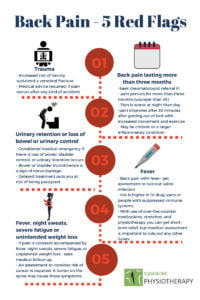Low back pain affects millions of people worldwide on a regular basis. The causes for back pain are often mechanical, i.e., pertaining to the muscles, joints, discs, or vertebrae. Pain in these areas can be caused by improper body mechanics with lifting or sitting, such as not bending at the knees when lifting or prolonged slouching when sitting. Most low back pain is acute and will resolve within four to six weeks. However, there are red flags to be aware of that require prompt medical attention.
Trauma
If the onset of the back pain occurred with trauma, such as a crush injury from a heavy object falling on the person or being pinned underneath a heavy object, medical follow-up is advised. With trauma, there is an increased risk of having sustained a vertebral fracture. An X-ray can be useful to rule this out.
Urinary retention or loss of bowel or urinary control
Low back pain is considered a medical emergency if there is a loss of bowel or bladder control or if urinary retention occurs. Bowel or bladder incontinence is a sign of nerve damage that, if not managed within a short period of time, can put the individual at risk of becoming paralyzed and losing the ability to walk. An emergency surgical assessment is required.
Fever, night sweats, severe fatigue or unintended weight loss
If the back pain is constant and occurs with fever, night sweats, severe fatigue, or unintended weight loss, medical follow-up is needed. A detailed medical assessment is required to consider the risk of cancer. A tumour pressing on the spine could be causing these symptoms.
Back pain lasting more than three months
Although chronic back pain may be a reality for some, for others, it may a symptom of a larger inflammatory condition. You should seek medical follow-up to assess for whether a referral to a rheumatologist is recommended if:
- low back pain persists for more than three months and is associated with being younger than 45
- pain improves after 30 minutes after getting out of bed with increased movement and exercise
- pain is worse at nighttime than daytime
Fever
Back pain that occurs with fever requires medical assessment to rule out an infection in the spine. The risk is higher in IV drug users or in people with suppressed immune symptoms, such as those undergoing chemotherapy or are positive for HIV.
Low back pain is a cause of physical and emotional discomfort. It can affect daily functioning and result in lost work days. While most low back pain will resolve in a short period of time with the use of over-the-counter medications, stretches, and possibly physiotherapy, it is important to be aware of these red flags that require prompt medical attention for appropriate management.
References:
Bratton, R. Assessment and management of low back pain. American Family Physician. November,1999.15;60(8):2299-2306.
Freburger, J. K., Holmes, G. M., Agans, R. P., Jackman, A. M., Darter, J. D., Wallace, A. S., ... Carey, T. S. (2009). The Rising Prevalence of Chronic Low Back Pain. Archives of Internal Medicine, 169(3), 251-258.
Toward Optimized Practice. Guideline for the evidence-informed primary care management of low back pain. Edmonton, AB: Toward Optimized Practice; 2011. Appendix A: Red and Yellow Flags. Available from: .topalbertadoctors.org/cpgs/?sid=65&cpg_cats=90



